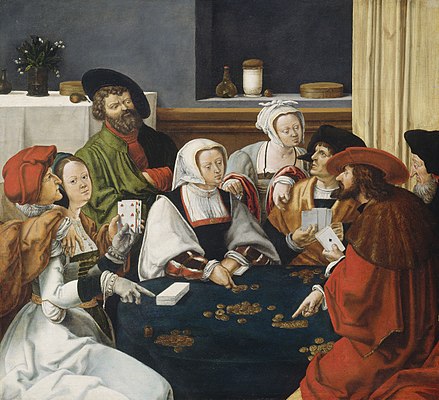The history of poker can be difficult to pin down precisely, with several different contenders for the first versionv of the game. It has been variously ascribed to the Persian game of As Nas, which used a special pack of cards with five different designs, making a 25-card pack with 5 suits. This dated from at least the Seventeenth Century, but began to be replaced by European style poker in the Nineteenth Century. The rules of play have been described as exactly like Poker, but without any sequences or flushes, so it’s a good contender for an original version.

However, there are other similar precedents to poker. In the Sixteenth Century, a game called Primero was commonly played. This was first mentioned in 1526, and is mentioned by both Rabelais and Shakespeare. It was even the subject of a madrigal by Striggio, and has been most firmly located in Italy, although it was played through most of Europe at the time. A painting by Zuccari of players in the Sixteenth Century suggests that this was a card with eight laid face-down and four in each player’s hand. It is difficult to work out the rules of the game from these details, but it seems to have been a gambling game, and in most repects, similar to modern-day Poker.
Brelan, a French card game, also claims to be the antecedent of Poker. This was a game that included gradually increasing bet. It was played with a 32-card pack, with each player receiving 3 cards, and the fourth would be turned up. The best hand would be a four of a kind, consisting of the three cards in the player’s hand and the fourth on the table.
Brag is a British game of the Seventeenth Century, which shares some features with Poker, in that it involved bluffing. This has its complete rules outlined in 1721, which also notes that it was very similar to an earlier game called Post and Fair, or which evidence exists of it being played in the early Sixteenth Century. The game involves three stakes, in which there is one for each stage of the game. Three cards are held by the players, with the final given to each player but dealt face-up. Betting then proceeded in three stages, firstly on the value of the upturned card, secondly through ‘bragging’ or upping the ante, and finally, according to which player scored thirty one.
The Origins of Modern Poker

Despite there being a number of similarities with these earlier games, Poker itself originated in the late Eighteenth Century, and spread through the Mississippi region. There were – and still are – a number of different forms of Poker, so identifying the specific origin of the game can be tricky. 20-card Poker was played by two players, although it was not until the game was played with the full 52-card pack and the flush was invented that the game really resembled the one we play today.
The American Civil War (1861-65) was responsible for many other innovations in Poker, from the five-card version, and the introduction of the straight. In 1875, it appears the wild card was introduced (although this concept was present in many earlier versions such as Blag) and split-pot Poker. Community Card Poker is only attested from 1825, in which cards are placed face-up in the table and the value of which can be shared by all the players. This is the first version of Texas Hold-‘em, which was then later developed in the 1920s.
The Growth of Poker
Despite Poker being played for centuries, its modern popularity can only really be traced to the 1970s. At the beginning of this decade, the World Series of Poker was created, and books were published on various tactics that could help players win. It began to be more frequently represented in films as a commonplace recreational game, and often was the most common game reflected in representations of gambling.
However, two key events led to the explosion in the game’s popularity: first, in 1987, California legalised versions of the game, including Texas Hold’em, which increased the variety of Poker games available to players. Secondly, the legalisation of Casinos on Indian Reservations meant that there was a substantial explosion in the availability of Poker games in the USA. From here, the game’s popularity spread worldwide.
Today, the Future, and Beyond

The next event that led to the explosion in the popularity of Poker was the availability of online Poker. This, together with new innovative techniques in the filming of tournaments, meant that huge audiences were generated for live games, and people could then practise and play in the comfort of their own homes. European and American Tours followed, and many professional players were able to combine their online and live experience.
Today, poker is more accessible than every before. Go onto an online casino like BoaBoa or BankonBet and you’ll be able to play practically any variant of the game. From its origins in dark taverns of Italy to its prominence in the glitzy lights of Vegas, poker has certainly come a long way. And what’s more, given the availability online of the game, it now offers something for everyone, from computer-based games to online games with a live dealer where you can play just as you would in a bricks-and-mortar casino. So now you know more about the origins of poker, it’s time to flex your skills and take a shot at glory.